Top Lace Materials: Your Guide to Elegant Fabrics
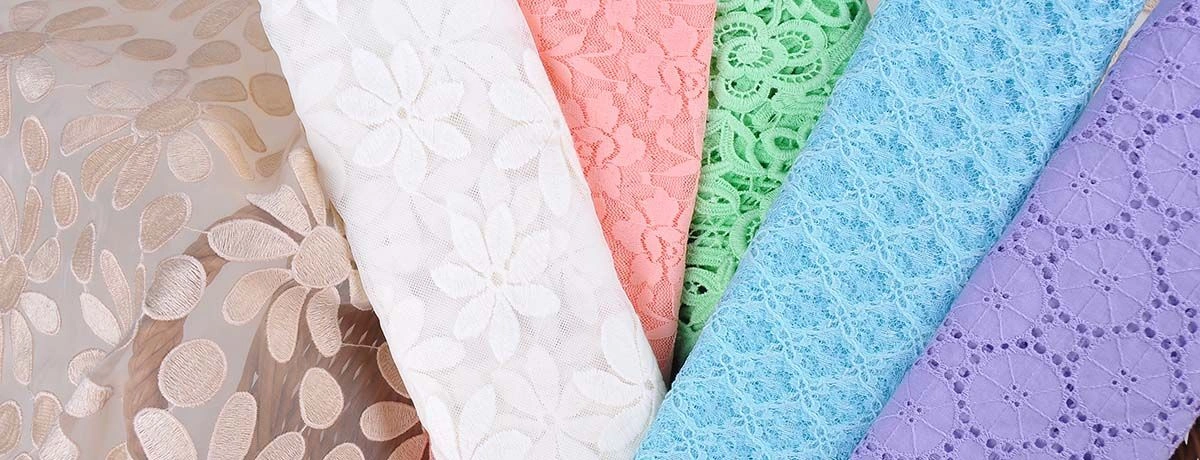
Lace materials add elegance and intricacy to fashion and home decor. In this guide, you’ll discover the various types of lace fabrics, their unique features, and how to choose the best one for your projects.
Key Takeaways
-
Lace materials are defined by their intricate designs and historical craftsmanship, elevating fashion and home decor with elegance and luxury.
-
Various types of lace, including bobbin, needle, and chemical lace, each possess unique qualities and applications, enhancing their versatility in textile design.
-
Natural fiber laces are more environmentally friendly compared to synthetic alternatives, highlighting a growing consumer emphasis on sustainability in the textile industry.
Understanding Lace Materials
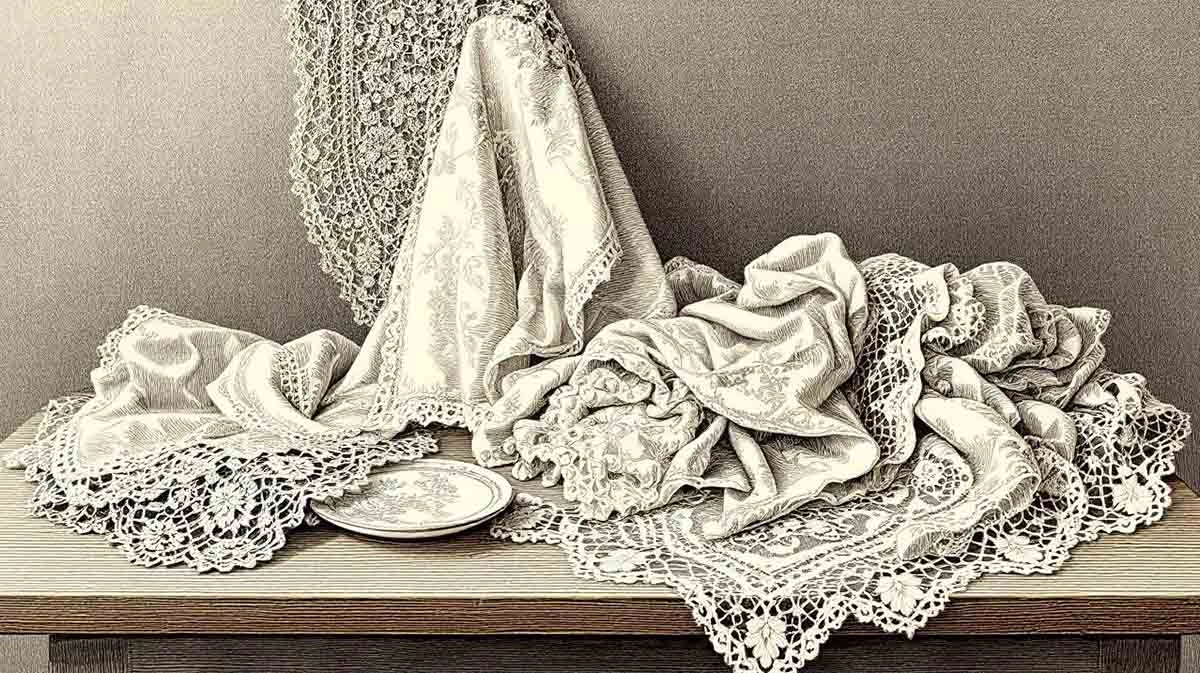
Lace is a delicate, weblike fabric extensively used for decorative purposes. This fabric adds an air of refinement and elegance to various projects, enhancing both fashion pieces and home decor items. Historically, lace has been crafted using silk or linen threads and sometimes incorporates gold or silver, making it a luxurious choice in textile design. The primary purpose of lace fabric is to elevate the appearance of other textile products, making them appear more sophisticated and luxurious.
In the realm of fashion, lace is particularly valued for its delicacy and complexity. It is a staple in bridal gowns and lingerie, where its intricate designs add layers of beauty and luxury. The addition of lace to bridal gowns, for instance, can transform a simple dress into a masterpiece of elegance and complexity.
Lace fabrics are predominantly produced in countries like China, France, the Netherlands, and Italy, with French lace being especially prized for its soft feel and elaborate floral patterns.
Understanding lace fabrics reveals their versatility in both decorative and functional applications. From the intricate patterns of French lace to the robust qualities of Italian lace, each type brings unique charm and sophistication to various projects.
Types of Lace Fabrics
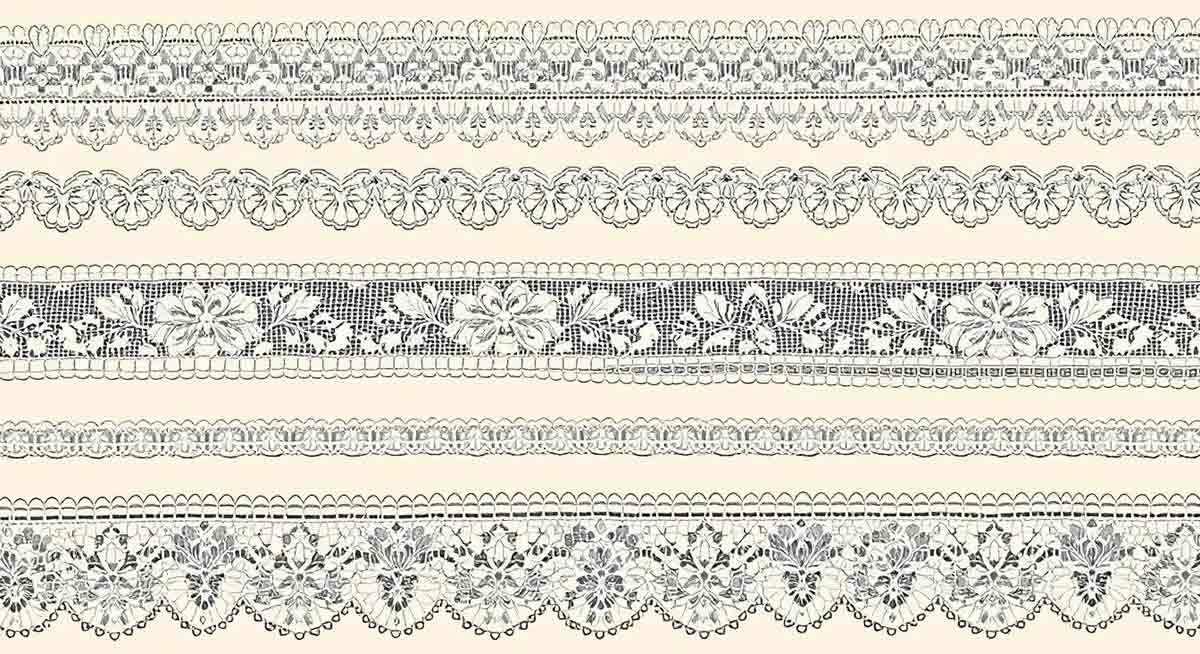
Lace fabrics are highly regarded for their intricate designs, which add a romantic and elegant touch to both fashion and home decor. The aesthetic appeal of lace comes from its ability to exhibit detailed patterns such as floral and geometric designs. Over the centuries, a wide variety of lace fabrics has emerged, each showcasing unique characteristics and applications.
The three primary methods of producing lace fabrics are:
-
Bobbin lace: Created by combining multiple threads into intricate patterns, often using traditional methods that have been passed down through generations.
-
Needle lace: Involves affixing guiding threads to a stiff background and using tiny stitches for precision, resulting in beautifully detailed motifs.
-
Chemical lace: Made by embroidering onto a base fabric that is later dissolved, leaving only the lace pattern behind.
Each type of lace fabric brings its own unique qualities to the table. From the highly elastic and comfortable knitted lace to the dimensional design of 3D floral lace, the many different types of lace fabrics available allows for endless possibilities in fashion and home decor.
Now, let’s explore these lace-making techniques in more detail, beginning with bobbin lace.
Bobbin Lace
Bobbin lace is a technique that involves using multiple threads wound on bobbins to create complex and intricate designs. This method is known for its meticulous craftsmanship and has been traditionally used to produce beautiful, delicate patterns. The interplay of threads in bobbin lace results in a lightweight fabric that is both decorative and functional.
This type of lace is particularly popular in bridal gowns, where its intricate patterns add a touch of elegance and sophistication. Whether used as overlays, trims, or appliques, bobbin lace enhances the beauty of wedding dresses, making them perfect for brides seeking a timeless and classic look.
The use of natural fibers like cotton and silk in bobbin lace further adds to its appeal, making it a preferred choice for creating luxurious and delicate fabric garments that embody softness.
Needle Lace
Needle lace is known for its meticulous craftsmanship, often involving small, precise stitches that create detailed motifs. The primary tools used in making needle lace include scissors, thread, and a needle, with which artisans create stunning designs that appear almost magical in their complexity.
Needle lace’s intricate patterns make it a popular choice for beaded bridal gowns and formal garments, adding sophistication and glitter to any sewing project collection featuring sequins.
The precision and beauty of needle lace are unmatched, making it a cherished technique in the world of perfect lace making.
Chemical Lace
Chemical lace is made by embroidering onto a base fabric that will later be dissolved. This method allows for the creation of intricate patterns without the need for a woven background, resulting in a lace fabric that appears almost ethereal in its delicacy.
Chemical lace production offers the advantage of creating complex designs with ease and efficiency. Often used in bridal gowns and formal garments, its delicate patterns add a touch of elegance.
The versatility of chemical lace makes it a popular choice for various sewing projects, from wedding dresses to decorative fabric accents.
Popular Lace Fabrics for Bridal Gowns

Globally recognized as a luxurious choice for wedding dresses, bridal lace offers various options, each with unique characteristics and beauty. Popular types include Chantilly, Alençon, and Guipure lace, each bringing distinct elegance and charm to bridal gowns.
Chantilly lace is celebrated for its delicate floral designs and light texture, making it a favored choice for bridal gowns. Guipure lace, known for its beautiful structure, is considered a romantic choice for wedding dresses, perfect for the bride.
Embroidered lace features intricate patterns that create stunning visual effects, perfect for formal bridal gowns. Brides seeking elegance and drama often prefer embroidered lace due to its elevated and luxurious look.
Chantilly Lace
Chantilly lace originated in Chantilly, France, and is celebrated for its delicate floral designs and light texture. This type of lace is often used in wedding dresses for overlays or appliques, adding a touch of timeless elegance to the gown.
Chantilly lace’s intricate patterns and soft feel make it a classic choice for brides seeking a feminine and ethereal look. Its delicate beauty enhances bridal gowns, perfect for a romantic wedding day.
Alençon Lace
Alençon lace features intricate floral designs integrated into a fine netting, creating a beautiful and durable fabric. This type of lace is distinguished by its floral patterns outlined with heavier threads, which add both elegance and durability to the fabric.
Alençon lace, with its refined net background and detailed patterns, adds sophistication to bridal gowns. Brides opting for Alençon lace can expect a durable and elegant fabric that enhances their wedding attire.
Guipure Lace
Guipure lace is known for its bold patterns and does not have a net background, making it a unique and striking choice for bridal gowns. This type of lace is often used to create dramatic and eye-catching designs, perfect for brides seeking a standout wedding dress.
Guipure lace’s bold patterns add romance and elegance to wedding dresses, ideal for brides wanting to make a statement. Whether used in full gowns or as accents, Guipure lace brings unique charm to bridal fashion.
Cotton Lace: A Versatile Choice
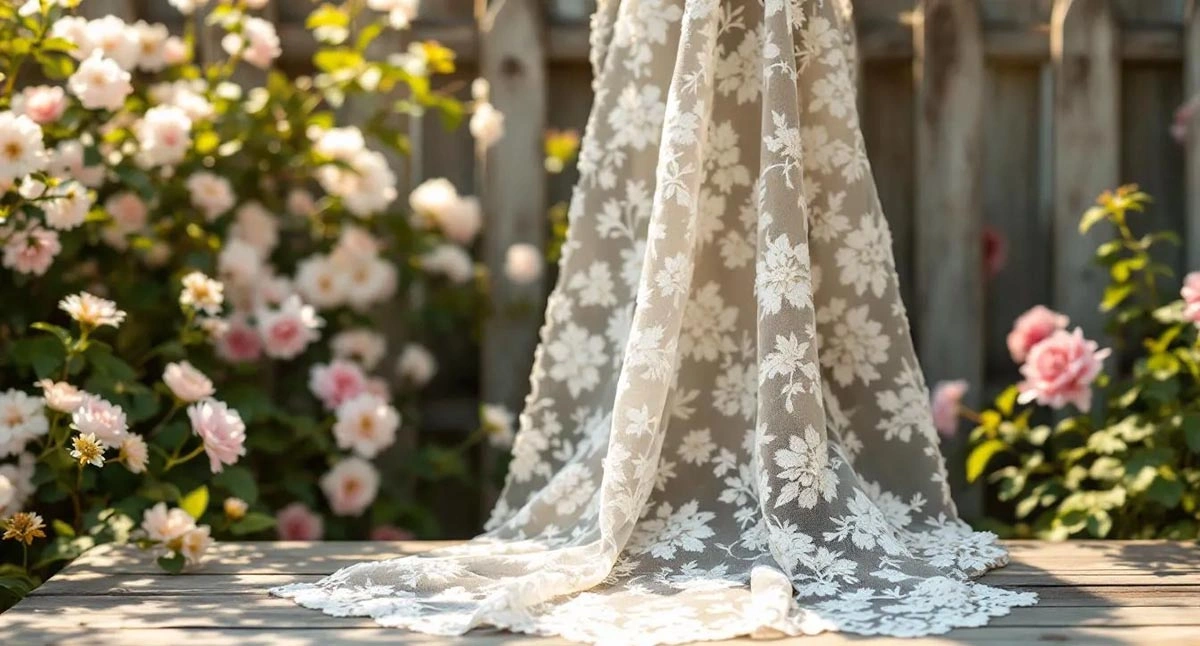
Cotton lace is crafted from natural fibers, making it both breathable and lightweight. The delicate interlacing loops of cotton lace enhance its breathability, making it ideal for warm weather. The versatility of cotton lace allows it to be used in various applications, from haute couture to casual wear and home furnishings.
The characteristics of cotton lace include:
-
Being breathable
-
Lightweight
-
Intricate in patterns
-
Soft to the touch
-
Durable
Compared to synthetic lace, cotton lace is recognized for its soft touch and durability. This versatility makes cotton lace a popular choice for fashion designers and home decorators alike.
Uses in Summer Clothing
The lightweight nature of cotton lace makes it perfect for airy summer outfits like dresses and blouses. Its breathability and comfort make it ideal for warm weather clothing, offering both style and practicality.
Cotton lace is commonly used in summer dresses and lightweight blouses, adding a touch of elegance and comfort to summer fashion choices. Overall, cotton lace adds both style and comfort to summer garments, making it a favorite among fashion designers and consumers alike.
Home Decor Applications
Cotton lace, a versatile fabric, adds elegance to home decor items like curtains and table linens, creating a sophisticated and inviting atmosphere.
The use of cotton lace in home decor items like curtains, table linens, and decorative accessories adds a timeless and classic charm to any room. Its delicate patterns and soft touch make it a perfect choice for enhancing the beauty of home furnishings.
Embroidered Lace: Adding Intricate Patterns
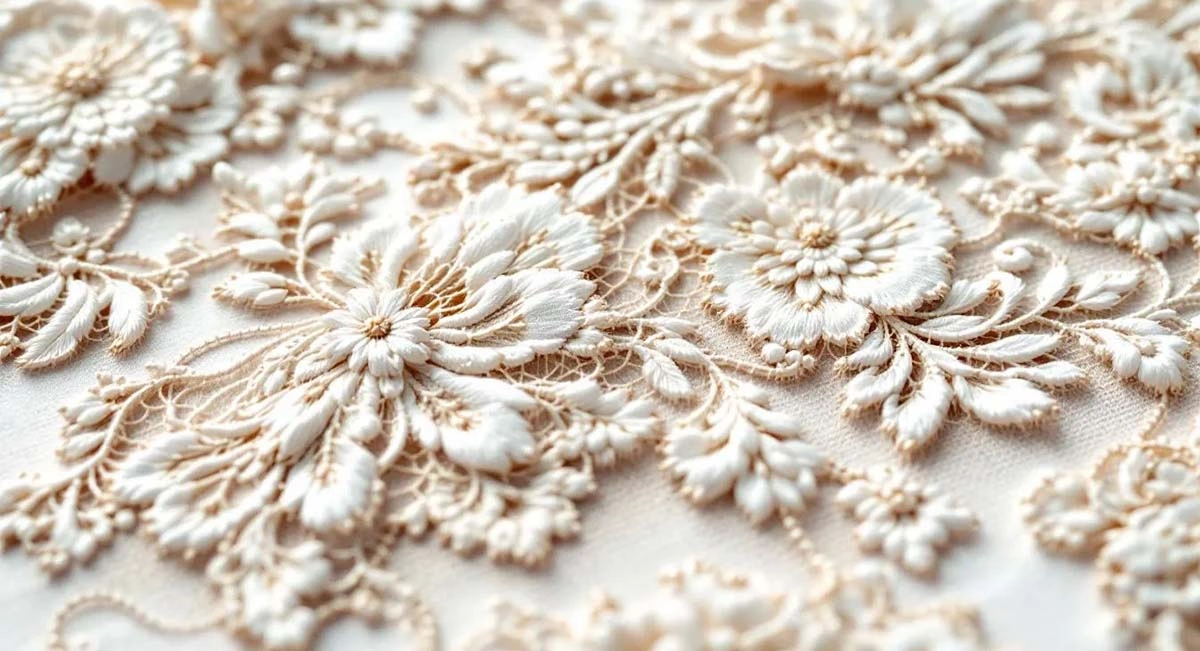
Embroidered lace, characterized by intricate patterns stitched onto an illusion base, creates a stunning effect, appearing to float directly on the skin like a delicate veil. Commonly found in bridal gowns, it is especially popular for long sleeves and high mesh necklines and backs.
The intricate patterns and stunning visual effects of embroidered lace make it a popular choice for formal bridal gowns. Its ability to create a beautiful and sophisticated look makes embroidered lace a favorite among brides and designers alike.
Synthetic Lace: Modern Alternatives
Synthetic lace materials tend to be more affordable compared to traditional lace, making them an attractive option for budget-conscious sewing projects. These modern synthetic laces can mimic the appearance of natural lace, offering similar aesthetic qualities without the higher cost.
Synthetic lace is often more durable and easier to care for than its natural counterparts, making it suitable for a variety of sewing applications. The versatility and affordability of synthetic lace materials make them a popular choice for modern fashion and home decor projects.
Environmental Impact of Lace Fabric
Natural fiber lace options, like cotton and silk, are biodegradable, making them more environmentally friendly than synthetic alternatives. However, the production of synthetic lace, made from materials such as polyester, leads to long-lasting waste and microplastic pollution.
Handmade lace employs minimal machinery and energy, significantly lowering its environmental footprint. The environmental impact of lace fabrics, including machine made lace, varies significantly depending on the materials used, with a growing emphasis on sustainability among consumers.
Lace Fabric Care Tips
Caring for lace fabrics is essential to preserving their intricate beauty and ensuring they last for many occasions. For minor stains, gently blot the area with a dry cloth and seek professional dry cleaning. Store lace garments using padded hangers or fold them with acid-free tissue to avoid creasing.
When storing lace long-term, use a breathable garment bag and place it in a cool, dry location. These practical tips will help maintain the beauty and longevity of your lace fabrics, ensuring they remain perfect for years to come.
Summary
Summarize the key points of the article, emphasizing the elegance and versatility of lace fabrics. Conclude with an inspiring statement about the timeless beauty and endless possibilities of lace.
